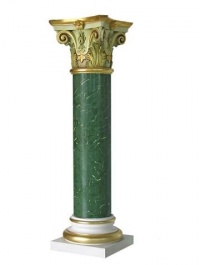Greek and Roman Orders in architecture

There are 2 main ancient architecture orders : Greek Order and Roman Order.
In Ancient Greek Order there are three styles : Corinthian, Ionic and Doric style. Roman order originates by Ancient Greek Order and consists of Tuskan and Composite order. The Roman adoption of the Greek orders took place in the 1st century BC. The three Ancient Greek orders have since been consistently used in neo-classical European architecture.
Greek Orders
Doric order
Sometimes the Doric order is considered the earliest order, but there is no evidence to support this. Rather, the Doric and Ionic orders seem to have appeared at around the same time, the Ionic in eastern Greece and the Doric in the west and mainland.
The Doric order originated on the mainland and western Greece. It is the simplest of the orders, characterized by short, faceted, heavy columns with plain, round capitals (tops) and no base. The Greek forms of the Doric order come without an individual base. They instead are placed directly on the stylobate. Later forms, however, came with the conventional base consisting of a plinth and a torus. The Roman versions of the Doric order have smaller proportions. As a result they appear lighter than the Greek orders.
Ionic order
The Ionic order is also marked by an entasis, a curved tapering in the column shaft. A column of the ionic order is nine or lower diameters. The shaft itself is eight diameters high. The architrave of the entablature commonly consists of three stepped bands (fasciae). The frieze comes without the Doric triglyph and metope. The frieze sometimes comes with a continuous ornament such as carved figures.
The Corinthian order is the most ornate of the Greek orders, characterized by a slender fluted column having an ornate capital decorated with two rows of acanthus leaves and four scrolls. It is commonly regarded as the most elegant of the three orders. The shaft of the Corinthian order has 24 flutes. The column is commonly ten diameters high. The Roman writer Vitruvius credited the invention of the Corinthian order to Callimachus, a Greek sculptor of the 5th century BCE. The oldest known building built according to this order is the Choragic Monument of Lysicrates in Athens, constructed from 335 to 334 BCE. The Corinthian order was raised to rank by the writings of Vitruvius in the 1st century BC.

The Colossal order was invented by architects in the Renaissance. The Colossal order is characterized by columns that extend the height of two or more stories.
On the picture on left it is an illustration of the five orders engraved for the Encyclopédie, vol. 18, showing the Tuscan and Doric orders (top row); two versions of the Ionic order (center row); Corinthian and Composite orders (bottom row).
Tuscan order
The Composite order is a mixed order, combining the volutes of the Ionic with the leaves of the Corinthian order. Until the Renaissance it was not ranked as a separate order. Instead it was considered as a late Roman form of the Corinthian order. The column of the Composite order is ten diameters high.



